You forget how big, how truly enormous, this bug is. Part of it’s the contrast: After a spring spent matching caddisflies, Hendricksons, and sulphurs—and pulling nothing out of your fly box larger than a dainty size 14—the first Hex of the season, battering heavily into the dusk like an overloaded Sikorsky, blows your mind.
This isn’t a mayfly. It’s Godzilla.
It’s the same with the way the trout respond. When you’re accustomed to those sipping rises that remind you of prissy Englishmen taking tea, the spectacle of trout gobbling Hexes is downright shocking. There’s something primitive, even savage, about it. Trout don’t dimple the water when they come up for a Hex. They crater it.
The Hex hatch brings out the beast, transforming the brown trout, this most reticent, least impulsive of fishes, into a frenzied feeding machine. Nothing makes them throw their famous caution to the wind the way Hexes do. This goes double for the really big browns, the ones anglers who restrict themselves to fishing daylight hatches almost never see. I get the sense that, because these lunkers play it so maddeningly cool and close to the vest 99.9% of the time, the Hex hatch represents their one chance of the year to vent their frustration, blow off some steam, and just go on a wild-ass bender.
“Hex,” of course, is short for Hexagenia limbata, the giant mayfly that a few old-timers call the “Michigan caddis.” By any name it’s the largest mayfly in North America, the duns commonly measuring 1½ inches or more in length—and that’s not including the tails. They emerge over silt, marl, or mucky sand bottoms, starting in mid- to late-May in the southern portions of their range and continuing well into July in more northerly areas.
Some of these emergences are Biblical. Those insect “swarms” you’ve heard about that show up from time-to-time on weather radar? Those are Hexes. County highway departments have been known to pull the snowplows out of storage to clear masses of pulped Hexes off of bridges.
Hey, I’m not kidding about that.
While Hexes hatch from the Adirondacks of upstate New York to parts of northern California and Oregon, the center of all things Hexy has always been the upper Midwest, Michigan and Wisconsin in particular. This brings up the other thing that sets these bugs apart: With rare exceptions, they only come out at night.
Much has been written about the weirdness of fly fishing at night, from catching bats—someone defined the Grand Slam of Hex fishing as hooking a trout, a tree, and a bat in the same session—to encounters with monstrous unidentifiable creatures that, for all you can tell in the inky darkness, were recently excreted from the bowels of hell. A good angler and widely experienced sportsman of my acquaintance got so spooked fishing the Hex hatch on a remote stream in northern Wisconsin that he swore off night fishing altogether. He doesn’t like to talk about it.
Once, walking out after a blizzard-like hatch and a couple pretty satisfying fish, I came upon two young guys squatting on their haunches at the edge of a DNR parking area. Between them, face-down, lay what appeared to be a dead body. Fortunately he’d only fainted (after slamming his hand in a car door) but for a few moments there I felt as if I’d stepped into a Cormac McCarthy novel.
Still, as bizarrely cultlike as this behavior appears to the average taxpayer, among those of us who actually do it there’s no mystery at all. Simply stated, the Hex hatch gives us our best chance, by far, to catch big trout on dry flies—the kind of trout that, as a practical matter, are almost completely out of reach the rest of the year.
So, shortly before sunset we stake out our spot, typically a bend with a deeply undercut bank and some kind of woody cover. Then, we wait. We’re not alone. The birds—waxwings, thrushes, warblers—sense what’s coming, too, and they perch expectantly in the streamside bushes, heads cocked, poised to swoop. The very air seems charged with anticipation. A lot of guys who fish the Hex hatch fire up cheap cigars to repel mosquitoes and no-see-ums but I’ve found this to be an example of the cure being worse than the affliction.
Sometimes you see them coming off, lumbering skyward in ragged squadrons before the splashes begin. Just as often, though, what heralds the beginning of the hatch is an eruption in the water. Jolted into a state of hyper-alertness, you swivel your head wildly to locate the spreading rings…
There!
The fish is cross-stream at the head of the bend, just this side of a massively tentacled root wad. You take a step or two to get in better position, check to find an alley for your backcast, and start working out line. The fly, a rubber-legged Nealy’s Hex in size 6 knotted to a 2X point, falls a mite short—this early in the hatch you can still see pretty well—so you pull off another foot of line, pick up, and cast again. By now you’ve detected more slashing rises both upstream and down-, and the hatch has ramped up so fast and furiously that Hexes are pinging off your rod and even deflecting moistly off your face.
The second cast is on the money, the fly disappears in a toilet flush glumph… and suddenly you’re tight to the biggest trout you’ve had on all year.
The rod bends to the corks, the line whipsaws the water. The trout digs for the wood but you bully it away, the stout tippet allowing you to dictate the terms of the engagement to a degree that feels unfamiliar—and strangely thrilling.
You finally get the fish’s head up and skid it into the net. You flip on your headlamp then and in that cone of light the brown’s rich colors seem to glow. It tapes 17½ inches, a wonderful trout in anyone’s book if not the behemoth that swims in the twitchy dreams of us confirmed Hexmeisters.
I did catch a trout like that once, a brown that looked as long as a northern pike when I glimpsed it in the water and proved to be so ridiculously large that after several failed attempts to net it the conventional way I used the net frame as a shovel and just sort of heaved it onto the bank. Odds are I’ll never catch another to match it but I fully intend to keep trying, stalking the night for things that go bump.





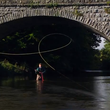

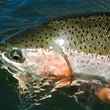












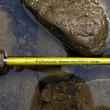



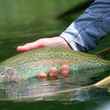
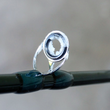


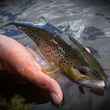

Comments
Todd Tanner replied on Permalink
Wonderful writing from a true master of the art.
bill "parachute" adams replied on Permalink
"...that after several failed attempts to net it the conventional way I used the net frame as a shovel and just sort of heaved it onto the bank." Classy. Thanks for sharing good catch and release techniques...
Pages